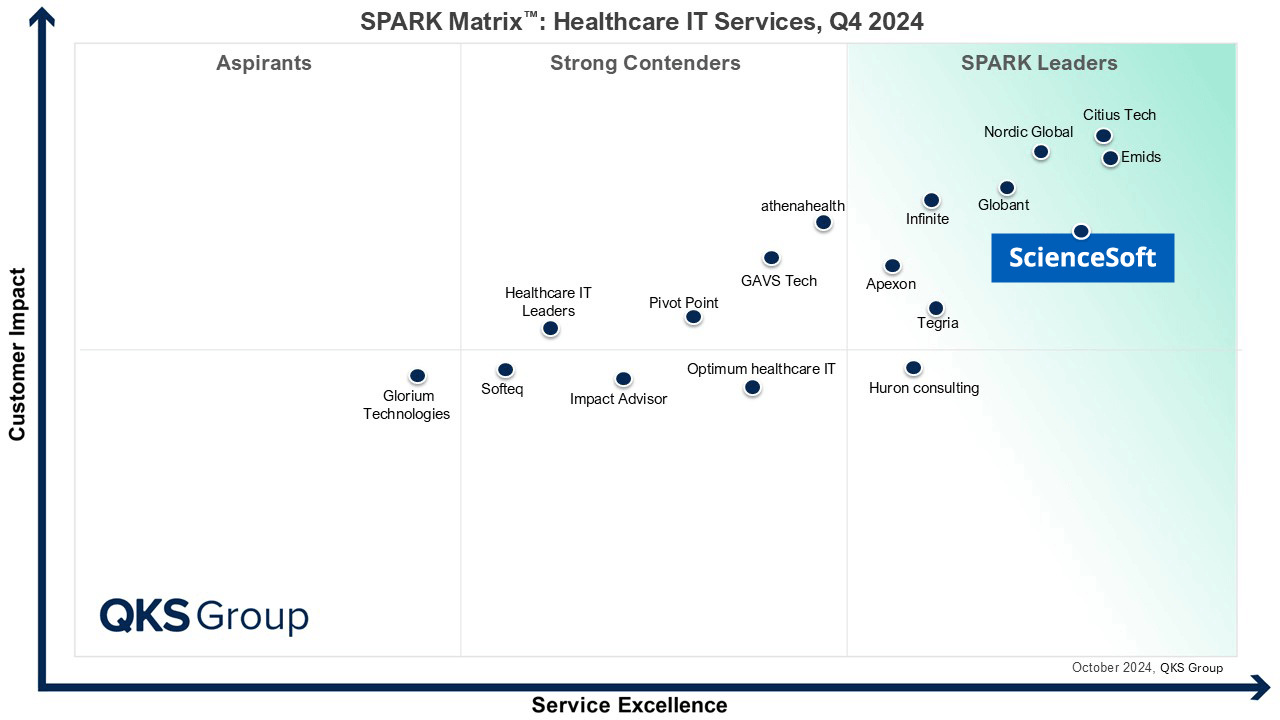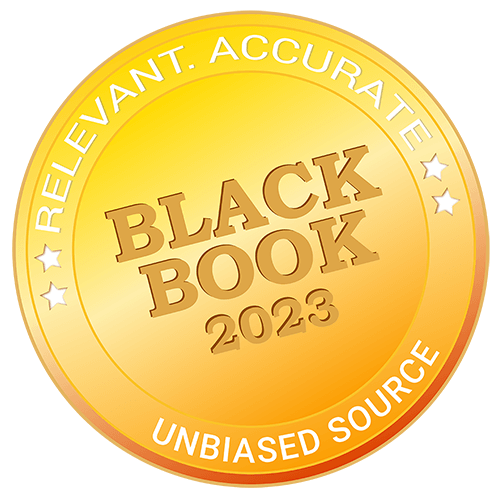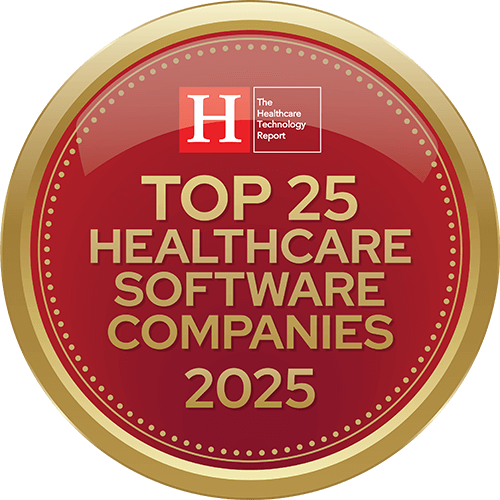Mobile Fitness App Development
Plan, Architecture, Costs
In mobile app development and healthcare IT since 2005, ScienceSoft builds world-class wellness apps with resilient architecture and engaging UX.
Fitness Apps: The Essence
The key goal of fitness app development is to meet the ever-growing demand for easy-to-use, accessible apps that help people maintain physical and mental wellness. Varying from fitness tracking, workout guidance, and nutrition planning to mindfulness solutions, fitness apps make a big difference in their users' everyday lives.
- Key steps: business analysis, requirements engineering and planning, UX/UI design, development and testing, release and maintenance, continuous evolution.
- Team: project manager, business analyst, solution architect, developers, QA specialists, DevOps engineer, regulatory compliance expert (optional).
- Costs: from $50,000 for an MVP and up to $600,000 for a full-featured product, depending on the chosen feature set and development method (native, cross-platform). Rely on our free calculator to estimate your project costs and gain confidence in budget planning.
As a healthcare app development company, ScienceSoft offers business analysis, design, coding, testing, support, and evolution of fitness apps of any complexity.
The Fitness App Market
The global fitness app market was estimated at $10.59 billion in 2024 and is expected to grow threefold within the following decade, reaching a valuation of $33.58 billion by 2033. The surge in demand for fitness apps is associated with the COVID-19 pandemic that raised public awareness of healthy lifestyle and affected brick-and-mortar fitness businesses.
Key Features of a Winning Fitness App
Having delivered over 350 successful mobile apps we fully understand the value of thought-out functionality. Below, ScienceSoft's consultants outline the most demanded fitness app features in 2023:
Sample Fitness App Architecture
Below, ScienceSoft's mobile app experts outline the key building blocks of a microservices-based fitness app architecture and describe its key components.

- Presentation layer is the app’s UI, the central point of user interaction. For fitness apps that accommodate different user roles (e.g., trainee, trainer, admin), different UIs with corresponding user access rights are created.
- Routing layer serves as an intermediary between the front end and the back end, ensuring a smooth and secure exchange of data.
- Container ecosystem is the app's back end that consists of several microservices and their respective databases, one for each primary module of the app.
Learn more about each microservice
Microservices in detail
- User's profile microservice collects and stores user data. Communicating with the payment microservice, it verifies a user's payment status (if applicable) and enables access to premium content or paid app features.
- Nutrition microservice helps log daily food and water intake, calculating the nutritional value of meals by choosing foods from the nutrition database or scanning a food item's barcode, etc.
- Training microservice contains the workout sessions and mental health exercises provided by the app. It allows users to choose their preferred activities and workout difficulty level, log their training sessions, track fitness progress, and more.
- Education microservice is designed to encourage the users' interest in fitness-related topics and provide comprehensive information about a healthy lifestyle in an easy-to-digest format.
- Goals microservice helps users keep up with their fitness goals, reminds them about missed activities, and encourages new accomplishments with push notifications.
- Recommendations microservice collects comprehensive data about a user's goals and activities from all the microservices to generate personalized recommendations and a tailored fitness program. Relevant tips might be provided with an AI chatbot that sends notifications to the user.
Hide
Independent modules are easy to deploy, scale, and modify, making microservices a perfect option for complex fitness apps that are likely to evolve with new features in the future.
Fitness App Development Roadmap
Below, ScienceSoft's experts share the key steps common for most fitness app development projects. This plan can be easily adapted to fitness app types, unique feature sets, etc.
1.
Discovery stage
- Setting business goals to be achieved with the future app (e.g., filling a market niche, promoting fitness products or services, etc.), define the expected goals to conceptualize the fitness product.
- Examining the target market segment and the competitors' offerings.
- Identifying the target audience and creating empathy maps to pinpoint potential users' pains.
- Identifying the app's compliance needs (e.g., HIPAA, GDPR).
- Developing a business case for the app, including the development cost and ROI estimations.
In most cases, fitness apps fall under the FDA requirements for low-risk devices as they are designed for general wellness use only, have no relation to diagnosing, curing, or preventing diseases and pose no risk to users’ safety. If your app fits this description, it will not require FDA submission.
2.
Requirements engineering and architecture design
- Creating a high-level vision of the fitness app by outlining:
- The app's purpose (e.g., an exercise guide, a fitness tracker, a nutrition advisor) and its competitive edge.
- The core feature set and integrations (if applicable).
- Functional and non-functional requirements, including security and compliance requirements.
- App monetization model (a paid app, in-app purchases, ads, etc.).
- Choosing the mobile platform (iOS, Android, both).
- Designing the optimal mobile app architecture.
- Selecting the best-suited back end technology stack.
- Creating a detailed software requirements specification (SRS).
3.
Project planning
4.
UX and UI design
- Conducting UX research to understand behavior of potential users and prioritize the development steps.
- Creating user personas and user scenarios (the patterns of how each persona interacts with the fitness app).
- Building UX wireframes or mockups that illustrate the interaction flows.
- Conducting multi-round UX testing to eliminate any potential issues and make the navigation intuitive.
- Creating a distinctive visual identity and fitness app design concept.
- Turning mockups into UI prototypes.
- Presenting UI prototypes to the project stakeholders, making the needed adjustments until the prototypes receive the stakeholders' approval.
5.
Development and testing (iterative)
- Setting up the development and delivery automation environments (CI/CD, container orchestration, etc.).
- Developing the server side of the system and the APIs, using secure coding practices.
- Developing the client side of the system: creating a full-fledged UI based on UI prototypes, setting up network communication, integration with databases.
- Implementing security features (e.g., data encryption, MFA, etc.).
- Integrating the app with third-party wearable devices, social media platforms, payment gateways, etc. (if applicable).
- Conducting end-to-end testing in parallel with development, including functional, performance, security and compliance, compatibility, and accessibility testing.
- For apps that collect PHI: Conducting a HIPAA compliance assessment.
6.
Release and maintenance
- Uploading the fitness app to the chosen mobile store(s).
- Selecting monitoring tools and setting up performance alerts to immediately detect and resolve availability and performance issues.
- Establishing support and maintenance procedures to ensure smooth operation of the fitness app: releasing updates to ensure full compatibility with new OS versions, addressing user issues, optimizing cloud resource consumption to reduce cloud fees, etc.
7.
Continuous evolution
Adjusting the solution to meet the evolving business needs:
- Rolling out new app features (including those powered by advanced techs like AR, IoT, AI/ML, etc.).
- Developing new integrations with other apps and services.
- Refining the UX/UI according to user feedback and new trends in the fitness industry.
- Implementing the most recent security measures and more.
Consider Professional Fitness App Development Services
ScienceSoft can design, develop, and support a highly engaging fitness app or assist you at any stage of your mobile development project. You set goals, we drive the project to fulfill them in spite of time and budget constraints, as well as changing requirements.
Why Your Fitness App Project Is Bound for Success with ScienceSoft
- In mobile app development and healthcare IT since 2005.
- 350+ successful mobile projects, including the Android version of Rakuten Viber, apps that power global brands (MTV, T-Mobile, Fox Entertainment), and Deloitte-approved banking apps.
- Hands-on experience with HIPAA, GDPR regulations.
- Strong Agile and DevOps culture.
- ISO 9001 and ISO 27001-certified to guarantee a robust quality management system and ensure the security of the clients' data.
- Quality management system for medical device software proven by ISO 13485.
Our awards, recognitions, and certifications

Featured among Healthcare IT Services Leaders in the 2022 and 2024 SPARK Matrix
Recognized for Healthcare Technology Leadership by Frost & Sullivan in 2023 and 2025
Named among America’s Fastest-Growing Companies by Financial Times, 4 years in a row

Top Healthcare IT Developer and Advisor by Black Book™ survey 2023
Recognized by Health Tech Newspaper awards for the third time (2022, 2023, 2025)

Named to The Healthcare Technology Report’s Top 25 Healthcare Software Companies of 2025
ISO 13485-certified quality management system
ISO 27001-certified security management system
Talents that Make Up Our Fitness App Development Teams
Project manager
Devises a project plan and manages the team; ensures full compliance with the SLA; reports to the stakeholders on the project progress.
Business analyst
Researches the fitness app market and competitors; elicits functional and non-functional requirements; outlines the feature set and the required integrations with third-party devices (if any).
Mobile architect
Designs the optimal fitness app architecture and the required integrations with third-party devices; chooses the best-suited tech stack.
UX designer
Investigates the needs and expectations of the fitness app's users; assists the business analyst in preparing the app's requirements specification; creates user personas and interaction patterns; builds UX wireframes and participates in UI creation.
UI designer
Designs an attractive and intuitive visual interface of a fitness app; cooperates with the UX designer and the developers to ensure easy navigation within the app and high user engagement; participates in discussing the UI prototypes with project stakeholders.
DevOps engineer
Sets up the fitness app development infrastructure; introduces CI/CD pipelines to automate development and releases; monitors the app's security, performance, availability, etc.
Mobile developer
Cooperates with designers to work out sleek GUI elements, codes the app and fixes the defects reported by the QA team.
Back-end developer
Builds the server side of the fitness app and establishes secure data exchange among the app's modules; fixes the defects reported by the QA team.
QA engineers and testers
Work out a test strategy and a test plan based on the app requirements; design test scenarios and test cases; set up the testing environment and run the tests; introduce test automation (if feasible); report on the detected issues; validate bug fixes.
Note: Depending on your project specifics, ScienceSoft can involve additional talents. For example, your fitness app collects personal health information and shares it with healthcare providers and insurance companies. In this case, a regulatory consultant will join the team to ensure the app's compliance with HIPAA and prepare the relevant documentation for an OCR audit.
Key Sourcing Models for Fitness App Development
How Much Does It Cost to Develop a Fitness App?
The cost of fitness app development may range from $50,000 to $600,000, depending on the chosen feature set, development method (native, hybrid, or cross-platform), and sourcing model (in-house or outsourced). Below are sample price ranges for fitness app development projects:
$50,000–100,000
For a native fitness app MVP with simple features like GPS tracking and diet planning.
$200,000–$300,000
For a cross-platform workout app with personalized user experience, goal setting, progress tracking across various modules, etc.
Up to $600,000
For a high-end native fitness app with advanced features like live streaming, AI chatbots, AR, etc.
View a sample fitness app development cost estimate.










